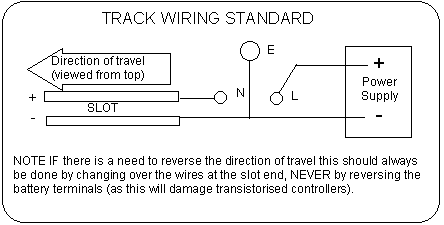
1
The slot width must be a
minimum of 3 mm and a maximum of 5 mm. The depth must be a minimum of 8 mm for
all new tracks. (existing tracks with a slot depth of at least 5 mm may be used
but the club must inform competitors of the actual slot depth in advance of the
meeting) At least one point in each lane shall have a slot depth of no more than
8 mm. The minimum lane spacing for all new tracks is 100 mm.
.
The recommended minimum lane spacing for new tracks for 1/24
racing is 110 mm
2. The contact surface on each side of the slot shall be not less than 3 mm or more than 6.5 mm in width, and at all points on the track there must be a pick up contact 5 mm from the center of the slot. NOTE tracks may have a short “dead” section on one straight for lap counting purposes.
3 Looking in the direction of travel, the positive contact shall be on the right of the slot and the negative on the left.
NOTE This aligns BSCRA with the way most ready to run and commercial set cars are wired. Up to 31 Dec 2002 BSCRA had the reverse (positive on the left) wiring. Any tracks not complying to the 2003 wiring from 1 Jan 2003 must give competitors advanced notice (in order to allow them time to rewire their cars).
4. Clubs must provide accurate lap recording equipment without additional fittings to the car being necessary.
5 The track voltage shall not drop more than 1V below the unloaded voltage at any point when each lane is drawing 4 amps. This is the mandatory minimum, however it is strongly recommended that the voltage shall not drop more than 1V below the unloaded voltage when each lane is drawing 10 amps
6 The track voltage shall not exceed 16 volts DC off load.
7. It is the responsibility of all clubs to ensure the minimum of AC 'ripple' in the power supply at the track.
8. Track must have either battery or regulated power supplies to meet the following:
(a) All track battery power supplies must include one or more 12V DC batteries with a combined capacity of at least 30 amp-hours, but preferably 100 amp-hours minimum.
NOTE: an average small car battery is around 30-40 amp-hours capacity.
(b) All tracks with regulated power supplies and no batteries must be able to supply a peak current of 18 amps per lane simultaneously to all lanes.
9. No personal external power supplies intended to enhance the performance or improve the braking of the cars are permitted. NOTE this prohibits any device which provide a higher voltage than the track positive supply voltage, and/or lower than the negative supply voltage.
10. Controller plugs are to be BS 546 3-pin, 2 amp type, wired as follows:
Live to power lead
Neutral to common lead
Earth to brake lead. (Tracks must be wired for dynamic braking.).
The live terminal shall be positive with respect to the earth and neutral terminals of controller sockets. (NOTE transistorised controllers will be damaged if this rule is not observed. The polarity shall be stated on meeting entry forms if it is not as above.)

NOTE
1 N, E and L markings are normally moulded into the plugs.
2 British made controllers normally come with wiring instructions for these plugs; American controllers are normally wired Black to N ; Red to E , White to L
Clarification - The motor power must be directly controlled by a speed controller plugged into lane's controller connector. Controllers that apply full power to the track all the time are not permitted.

NOTE - error in previous diagram corrected September 2006, clarification added November 2021
Copyright © 1964 - 2023 British Slot Car Racing Association All rights reserved